Elizabeth Turk
A native Californian, Elizabeth Turk is an artist, known for marble sculpture and community installations. Currently, she splits time between a studio in Santa Ana, CA and NYC. She is a MacArthur Fellow, an Annalee & Barnett Newman Foundation recipient and a Smithsonian Artist Fellow among other awards. Turk received her MFA from Maryland Institute College of Art, Rinehart School of Sculpture in 1994, her BA from Scripps College, Claremont, CA in 1983. She has been represented by Hirschl & Adler, Modern in NYC since 2000. In 2017 she launched ET Studios (a CA non-profit) to develop open community experiences. Turk’s marble work searches the boundaries of paradox: the contemporary in the traditional, the lightness in weight, the emptiness in mass, the fluidity of the solid, extended time in a moment. Her intricately carved sculptures defy gravity and make possible that which seems impossible. Inspired by the natural world, she references its myriad of elegant organic structures, yet her work is not complete until abandoned to larger environments. Her moving experiences are drawn from concepts developed in her sketchbooks over many years. They too, are inspired by nature yet rely on audience participation to stimulate works of collective memories, reminding us of civic grace and joy.[1][2][3][4][5][6][7]
Elizabeth Turk | |
|---|---|
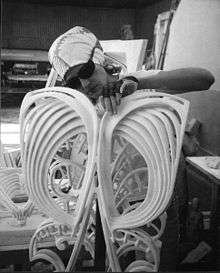 | |
| Born | 1961 |
| Nationality | American |
| Alma mater | Scripps College, Rinehart School of Sculpture |
| Known for | sculpture, manipulated photography |
| Awards | MacArthur Foundation Fellowship, Smithsonian Artist Research Fellowship, Barnett & Annalee Newman Foundation Fellowship, Joan Mitchell Foundation Grant, NYC Art Commission Award for Excellence in Design |
| Website | elizabethturkstudios |
Biography
Turk was born in California in 1961 and grew up in the western United States. The natural and cultural surroundings of the various locales she called home, specifically the Pacific Ocean along the Southern California coastline and the Native American culture in New Mexico, served as visual influences for her work.
She moved to Washington, D.C. to pursue a career in international relations and lobbying [8] upon graduating from Scripps College in Claremont, CA in 1983. The nation's capital, with its museums and courses at the Corcoran Gallery of Art, became the influence that drove her to pursue sculpture as a career. She enrolled full-time in the Rinehart School of Sculpture at the Maryland Institute College of Art in Baltimore, graduating in 1994.
Shortly after receiving her MFA, Turk began exhibiting her bronze sculptures in the D.C. area. The Baumgartner Gallery paired her work with sculptor Louise Bourgeois, whose dramatic bronze "Spider (Bourgeois)" compelled Turk to expand into a new medium. Choosing marble, she found cast-off stone from the 19th century construction of the Lincoln Memorial. Her segue to marble started a journey of exploring that material’s many possibilities; she is largely self-taught in the medium.[9] She began shaping stone into objects that defy their materiality, speaking to larger spiritual issues.
Turk moved to New York City in the mid-1990s and soon began showing her work there. Her first exhibition, “New York Classicism, Now," was in 2000 at Hirschl & Adler Galleries.[10] Hirschl & Adler Modern, New York has represented her from 2000 to the present.
Works
In her sculpture, Turk works primarily with marble, but also has mastered a variety of media, molding forms in wax and clay, casting objects in bronze and iron, and working with fragile material such as glass and porcelain.
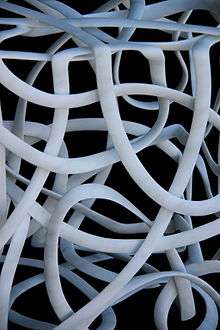
She painstakingly transforms solid 400-pound blocks of Sivec and Carrara marble into improbable shapes. Turk creates many of her marble pieces from pre-existing structures. For example, Ribbon #17 was formed from an Italian marble banister[11] once housed in an 18th century loggia. She has said she aims to "initiate conversation" with her artwork, rather than "overwhelm senses or to promote viewpoints."[11]
Asked about her choice of medium, she said, "Marble found me. It is intrinsically beautiful and holds great history. Maintaining a contemporary voice in this traditional material is daunting. But marble is the pathway to connect my work to the past, to a larger story– human and geological...It's not an accident that I read the earth like a novel. I want this depth in the artwork I create. This is important– it's humbling. My work carries forward more than my singular vision, because of this history."[12]
From her studio in a commercial marble yard in California,[9] Turk creates her works that play with gravity and paradox, exploring the contemporary and the traditional, lightness and weight, emptiness and mass.[13]
Her fascination with patterns results in large, intricately latticed collars and ribbons of undulating waves, evoking both man-made and organic forms: starched lace, Elizabethan ruffs, pinwheels, flowers, even the double helix of DNA. A testament to Turk’s remarkable technical ability, the marble works are a study in contrasts—solid material appears weightless, liquid, buoyant, illustrating the tension between both the inherent strength of the stone and its fragility.
"My work plays with intuitive notions of gravity. As I fold the precarious strips of my ribbons, I adapt to the various restrictions in the stone that emerge unexpectedly in the course of carving. These ribbons are shaped more by the structure from which they are born than by concepts growing in a vacuum," she explained in the Hirschl & Adler 2008 catalog, “Elizabeth Turk: Recent Sculpture."[11]
Turk sometimes also exposes her sculptures to the elements in a process of changing context, "letting go," and allowing something big—like the ocean—to transform it,[14] as she noted in an episode of Articulate on PBS.
In addition to the sculptures, Turk has created projects utilizing tools and media as varied as experimental photography (Mandalas, created after her 2011 Smithsonian Artists Research Fellowship),[15] video (Crane Project, created with Japanese artist Kirara Kawachi as a response to 9/11)[16] and paper airplanes (Airplane Collage, inspired by March 20, 2003).[17] Her work also features drawing and installation.
Selected Exhibitions
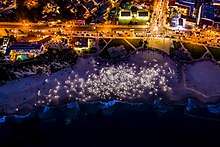
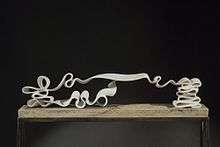
- Tipping Point (2019): ET Studios, a non-profit set up by Elizabeth Turk, and Elizabeth Turk introduce a new body of work Tipping Point. Turk’s work on the exhibition Tipping Point began earlier last fall, 2018, during a month-long open studio/live exhibition ThinkLab LIVE .002 with Director of The Frank Doyle Arts Pavilion Tyler Stallings, at Orange Coast College. Highlighting various attributes of this continents’ birds, Turk developed an alphabet of symbols. Using these unique symbols, she explores the greater concept – Extinction. Tipping Point has three elements:
- 1- Echoes of Extinction: Inspired by recordings of extinct birds (cataloged by the Ornithology Lab at Cornell University) the sound waves take shape in evocative sculptural, "sound column" forms, juxtaposing the ephemeral with the eternal.
- 2- Migration Patterns: metal mazes laced with imagery are cut to create beautiful interactive moments. Where the audience becomes both victim and aggressor in the fate of our planet.
- 3- Are We Creating a Silence?: a community, interactive experience where participants investigate the unique personal traces we leave behind.
- Shoreline Project (2018): ET Studios, a non-profit set up by Elizabeth Turk, produces the Shoreline Project as a community event in partnership with Laguna Art Museum. One thousand umbrellas with the image of seashell mandalas are lit using an LED shaft, and carried by volunteers who become the artwork itself. For 2.5 hours, community volunteers and 8 to 10 dance groups move to drum beats as the sun sets on Laguna Beach, CA.[18][19]
- Tensions (2015): the series juxtaposes carving with found natural elements such as worn river stones and wood in order to explore the inherent tensions between human temperament and the natural world.[20]
- Script (2014): a memorial to hand writing itself, lost in the overwhelming rise of the keyboard. This series is an elegant reminder of the direct calligraphic line of cursive.[21]
- Nature Memorial - Wings (2013): a series of five life-sized broken wings, made from Yule marble originally quarried for the Lincoln Memorial in Washington DC. Installed then photographed in abandoned industrial environments surrounding Washington D.C., the work is a symbol for the end of the 20th century of the Platonic idea: "God gives wings to those who can't fly."[22]
- X-Ray Mandalas (2013–present): part of this collection of experimental photography was acquired by the Phyllis and Ross Escalette Permanent Collection of Art and is housed at the Harry and Diane Rinker Health Science Campus at Chapman University.[23] Other pieces from the collection were recently installed at the Jacobs Medical Center at UC San Diego Health.
- Cages (2012): artwork carved from a single block of marble into a line outlining the interior space of the once, solid rock. Suspending this marble Möbius strip above a stainless steel structure, the polished interior of the steel reflects the empty state of the block of stone. The material, which is no longer seen, gives weight/meaning to that which remains visible. The works are about paradox, contradictory truths within the same boundaries; absence defining presence, lightness in weight, mass in emptiness, nests in cages, simplicity within complexity, the contemporary within the traditional.[24]
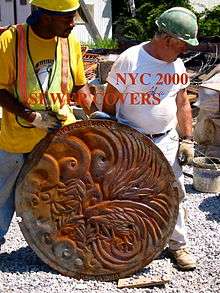 ManholeCover.ElizabethTurk
ManholeCover.ElizabethTurk - Ribbons and Pinwheels (2008): brings the study of individual shapes together to form extreme curves or "ribbons," particles acting fluidly to defy gravity. This body of work acted as studies for the Cage series.[5]
- Collars (2006): a series built upon studies of essential shapes in natural patterns forming systems that are strong enough to defy gravity and translate into stone matrices. The fragility of this latticework of the collars emphasizes the paradox inherent in the material.[25][26]
- New York City Manhole Covers (2000): Turk designed manhole covers for Wolfe's Pond Park in Staten Island, New York. Her designs combine the imagery of the Great Blue Heron, Osprey, and plant life on Staten Island, specific to the Staten Island Bluebelt, a natural wetland area that environmentalists are struggling to protect.[27][28]
Turk's work is also in the collections of the National Museum of Women in the Arts, Washington, D.C.; the Weatherspoon Gallery, University of North Carolina, Greensboro; The Mint Museum, Charlotte, NC; The Treasury of Lichfield Cathedral (UK); and the Los Angeles County Museum of Art. Turk's work has been shown in several solo gallery and museum exhibitions, including, "Elizabeth Turk: Sentient Forms" (2014) at Laguna Art Museum.[29] She has exhibited at the ADAA Art Show,[30] Dayton Art Institute, Dayton Ohio; Ben Maltz Gallery at the Otis College of Art and Design, L.A.; Ruth Chandler Williamson Gallery, Scripps College,[31] Claremont, CA; American Institute of Architecture, New York, N.Y.; and Japan Bank Building, Hiroshima.
Awards and Recognitions
Turk is the recipient of many awards and grants, including: a MacArthur genius grant,[32][33] and the Barnett and Annalee Newman Foundation Fellowship,[34] both in 2010; a Smithsonian Artist Research Fellowship (SARF) in 2011;[35] and a Helena Modjeska Cultural Legacy Award for artistic achievements from Arts Orange County in 2012.[36] She also won a Joan Mitchell Foundation Grant[37] and the NYC Art Commission Excellence in Design Award,[38] both in 2000. She was a 2003 Artist-in-Residence at the McColl Center for Art + Innovation[39] She delivered commencement addresses at Scripps College (2011)[40] and Laguna College of Art & Design (2016).[41] She is featured in the book 50 Contemporary Women Artists,[42] edited by John Gosslee and Heather Zises. In 2019 she delivered the commencement address for VCUarts at Virginia Commonwealth University.[43]
References
- "Elizabeth Turk — MacArthur Foundation". www.macfound.org. Retrieved 2016-10-11.
- Liz Goldner STONER: ELIZABETH TURK “Artist Brings New Life to Old Materials,” Artillery, November 2014.
- Laura Bleiberg “From Marble to Ribbons, Cages, and Collars,” Orange Coast, September 2014.
- Evan Senn “The Marvelous Marble of Elizabeth Turk,” KCET.org, 16 October 2014.
- TedX Atlanta Archived 2015-03-19 at the Wayback Machine Elizabeth Turk: Creativity, 2011.
- Rachel Wolff “Finding Strips of Ribbon in Chunks of Stone,” The Wall Street Journal, 22 June 2012.
- Mila Pantovich “Artist Elizabeth Turk Crafts Intricate Marble Sculptures,” JustLuxe, 18 July 2012.
- Ollman, Leah. "Revealing the Heart of Stone". 2004-07-24. Los Angeles Times. Retrieved 2 October 2010.
- Wolff, Rachel (June 22, 2012). "The Wall Street Journal". Finding Strips of Ribbon in Chunks of Stone. Retrieved October 11, 2016.
- Hirschl & Adler Galleries, about Archived 2015-03-01 at the Wayback Machine retrieved March 10, 2015.
- Turk, Elizabeth. Elizabeth Turk: Recent Sculpture. New York, NY: Hirschl & Adler Modern, 2008.
- "artnet Asks: Elizabeth Turk Talks Marble | artnet News". artnet News. 2015-10-20. Retrieved 2016-10-12.
- "Statement". Elizabeth Turk. Retrieved 2016-10-12.
- "Elizabeth Turk: The Edge of Gravity." PBS. 19 Dec. 2017, https://www.pbs.org/video/elizabeth-turk-edge-gravity-dm71bz/.
- "Mandalas". Elizabeth Turk. Retrieved 2016-10-12.
- "Elizabeth Turk and Kirara Kawachi". Grand Central Art Center. California State University, Fullerton. Retrieved October 11, 2016.
- "Airplane Collage". Elizabeth Turk. Retrieved 2016-10-12.
- Licari, Katie. "1,000 umbrellas light up Laguna's Main Beach for artist's 'Shoreline Project'". latimes.com. Retrieved 2019-01-10.
- Fung, Lisa. "Elizabeth Turk's illuminating social sculpture will light up a beach with 1,000 glowing umbrellas". latimes.com. Retrieved 2019-01-10.
- "Sculptor Elizabeth Turk's Shades of Gray". Coldwell Banker Inside Out. Retrieved 2016-10-12.
- "Paradox at Masterpiece London 2014 | Huffington Post". The Huffington Post. Retrieved 2016-10-12.
- Moss, Meredith (October 26, 2013). "Wings sculptures now on display at Dayton Art Institute". Dayton Daily News. Retrieved October 11, 2016.
- "New Artwork Adorns Rinker Health Science Campus". Art Collections at Chapman University. Retrieved 2016-10-12.
- Hirschl & Adler Exhibition March 2012.
- Leah Ollman "Revealing the heart of stone. Los Angeles Times, 11 July 2004
- Laura Janku "Elizabeth Turk: The Collars, Sculpture Magazine, September 2006.
- NYC Art Commission Archived 2010-05-26 at the Wayback Machine Elizabeth Turk: New York City Sewer Covers, 2000.
- David W. Dunlap "When City Hall Smiles on Public Art," The New York Times, 26 April 2001.
- Laguna Art Museum announcement Elizabeth Turk: Sentient Forms, October 2014.
- "The ADAA Art Show Draws Major Collectors, Art Professionals, and Enthusiasts For Strong Sales at 2017 Edition". R+A. 2017-03-07. Retrieved 2019-01-15.
- "Elizabeth Turk | Ruth Chandler Williamson Gallery". rcwg.scrippscollege.edu. Retrieved 2016-10-17.
- Tom Legro “Conversation: Sculptor Elizabeth Turk” Jeffrey Brow Transcript, PBS NewsHour, 29 October 2010.
- "Elizabeth Turk — MacArthur Foundation". www.macfound.org. Retrieved 2016-10-17.
- "About the Foundation - The Barnett Newman Foundation". www.barnettnewman.org. Retrieved 2016-10-17.
- "Smithsonian Awards 13 Artist Research Fellowships | Newsdesk". newsdesk.si.edu. Retrieved 2016-10-12.
- Arts Orange County past award winners retrieved March 10, 2015.
- Foundation, Joan Mitchell. "Joan Mitchell Foundation » Artist Programs » Artist Grants". joanmitchellfoundation.org. Retrieved 2016-10-12.
- "Design Commission - Nineteenth Annual Design Awards". www1.nyc.gov. Retrieved 2016-10-12.
- Elizabeth Turk Wins 2010 MacArthur Award The Mint Museum
- Scripps College 2011 Commencement Address Elizabeth Robbins Turk ’83, “What is True in Permanent Change?” 15 May 2011.
- "Laguna College of Art and Design Bestows Degrees on Largest Graduating Class In History". ArtfixDaily. Retrieved 2016-10-12.
- 50 contemporary women artists : [groundbreaking contemporary art from 1960 to now]. Gosslee, John,, Zises, Heather,, Sackler, Elizabeth A. Atglen, PA. 2018. ISBN 9780764356537. OCLC 1064676444.CS1 maint: others (link)
- "Elizabeth Turk's May 2019 Commencement Address". VCUarts. 23 May 2019. Retrieved 5 June 2019.
External links
| Wikimedia Commons has media related to Elizabeth Turk. |